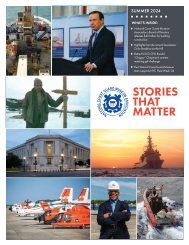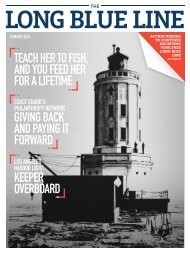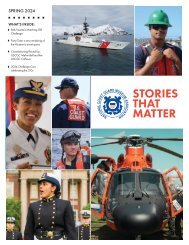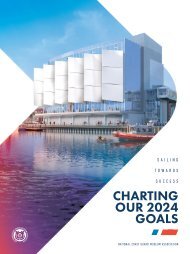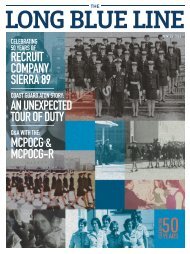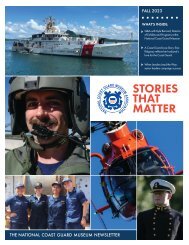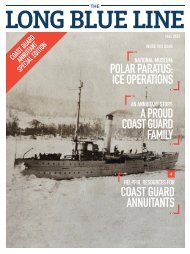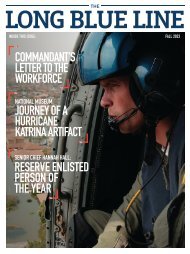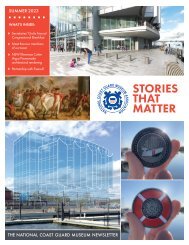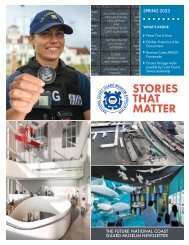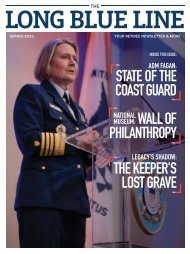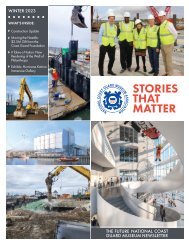The Long Blue Line (Summer 2020)
The United States Coast Guard's retiree newsletter and more.
The United States Coast Guard's retiree newsletter and more.
Create successful ePaper yourself
Turn your PDF publications into a flip-book with our unique Google optimized e-Paper software.
LIFESAVERS AROUND<br />
THE GLOBE WING<br />
<strong>The</strong> Lifesavers around the Globe Wing introduces visitors to the<br />
most fundamental responsibility of the Coast Guard: to protect<br />
the lives and safety of our citizens. During daily operations<br />
and in times of crisis, heroic teams work together to save<br />
lives on land, sea, and air.<br />
<strong>The</strong> galleries within this wing highlight the innovative<br />
technologies and teamwork required to search the<br />
seas for vessels in distress and perform rescues by<br />
air. A series of scenic installations anchor stories of<br />
boat rescue, lifesaving technology, search and rescue<br />
operations, mass rescue, and humanitarian relief efforts,<br />
including the Coast Guard’s unprecedented response<br />
in the aftermath of Hurricane Katrina.<br />
At the Coast Guard Station: Coast Guard search and<br />
rescue operations depend on command centers, multimission<br />
stations with assets like boats and aircraft, all linked<br />
together by communications systems. When a distress call<br />
comes in, the network gets to work. Information flows from the<br />
Sector Command Center to the Coast Guard stations nearest the<br />
incident. Boat crews or air crews are ready to respond within 30<br />
minutes of receiving the call.<br />
Evolution of Boat Rescue Gallery: <strong>The</strong> development of motorized<br />
lifeboats was a milestone in Coast Guard search and rescue. Motorpowered<br />
boats changed Coast Guard search and rescue forever.<br />
Boat crews used to bravely row out to a rescue scene. Now they<br />
had the power of a motor behind them. <strong>The</strong>y could go farther and<br />
faster than ever before, in the service of others.<br />
Fixed Wing Aircraft Gallery: <strong>The</strong> Coast Guard operates over 200<br />
aircraft – airplanes and helicopters – to support its work as a law<br />
enforcement arm, a military service branch, and a seafaring service.<br />
Nearly all Coast Guard aircraft have some role in homeland security<br />
operations. Fixed-wing aircraft, such as the HC 130 Hercules, are<br />
built for long range missions and operate from air stations. <strong>The</strong><br />
Coast Guard operates its aviation fleet on the principle that it cannot<br />
afford a fleet of aircraft intended solely for specialized missions,<br />
and has concentrated on aircraft that can carry out a wide range<br />
of diversified missions.<br />
Helicopters and Hoists Gallery: CDR William<br />
Kossler and LCDR Frank Erickson were true<br />
Coast Guard innovators who envisioned the<br />
potential of new helicopter technology in search<br />
and rescue. Visitors learn about the history of<br />
the helicopter hoist through graphics and an<br />
artifact on display.<br />
Hurricane Katrina Immersive Gallery: In<br />
response to Hurricane Katrina, the Coast Guard<br />
responded with unprecedented resourcefulness<br />
THE LONG BLUE LINE SUMMER <strong>2020</strong><br />
35



